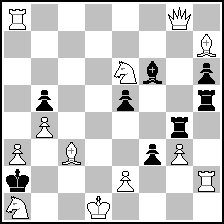
Website founded by
Milan Velimirović
in 2006
23:03 UTC


| |
MatPlus.Net  Forum Forum  General General  Classic 2+2+2 Twomovers Classic 2+2+2 Twomovers |
| |
|
|
|
|
You can only view this page!
| | | (1) Posted by David Knezevic [Tuesday, Jan 30, 2007 15:12] | Classic 2+2+2 Twomovers
Some of you may know, but many don't, that I was the one who proposed the (controversial?) two-move theme for 7th WCCT. My intention was to remind the composers how enjoyable it can be to compose classic single-phase twomovers, as well as to prove my opinion that even this type is far from being exhausted - just requires some persistance and a lot of knowledge and/or skill of composer. Many excellent compositions had been submitted for the twomovers group, many more published in subsequent years.
Unfortunately, one of the best (thanks to the expert judging!) could not find its place between the ranked entries in WCCT, but composer got the satisfaction by winning the (Yugoslav?/SCG/Serbian?) National championship. Here is the masterpice commented by Barry P. Barnes:
Marjan Kovačević
1.Pr National Champ. 2003-2006
 (= 9+6 ) (= 9+6 )
#2 | 1.Kb5! ~ 2.Rc4#
1... Qe2:+ 2.Scd3#
1... Qe8+ 2.Sd7#
1... Qd5 2.Sc6#
1... Bc3 2.Sc2#
1... Bc1: 2.Sd5#
1... Be3 2.Sbd3#
(1... Se4 2.Re4:# 1... Qc5:+ 2.Bc5:#
(1.Qb3? 1... Qd5! 1.Qb5? 1... Bc1:!)
Why this supremely beautiful and elegantly keyed problem did not feature - highly - in the 7.WCCT for problems with at least three thematically related pairs of mates, I do not know. It has what most of the wholly predictable WCCT problems do not - subtle and excellent mates that demand more than a moment's thought. It cannot be, but a WRa4 would work just as well. This powerful and harmonious problem is to be quoted with relish. [judge B.P.Barnes] |
I will take this opportunity to show you two interesting and probably less known classics which are very close to "three times two variations" form.
First is by the Italian genius Giorgio Guidelli.
Giorgio Guidelli
Good Companion 1917
 (= 9+13 ) (= 9+13 )
#2 | 1.Re6! ~ 2.Qd7#
1... Sgf5 2.Shf4:# (2.Sdf4?)
1... Shf5 2.Sdf4:# (2.Shf4?)
1... cd3,c3 2.c4,Sb4#
1... Bc6,Bb4 2.Qc6:,Sb4:#
1... Qe6: 2.Qc5#
Barulin dual aviodance - some ten years before Barulin even started to study the area!
Two other pairs of variations are overshadowed by a sparkling main theme, and one mate is repeated, so this is not quite 2+2+2 form - but great problem anyway!
Black Pf4 is superfluous, but such cases happen even today when we have the help of computers - at some moment of creation that pawn was necessary, so later by inertion composer left it there! |
Second example shows the so called Barthélémy theme (shortly defined as black focal guard of white battery line) in no less than four variations!!
G. M. Fuchs
1.Pr France–Spain 1937
 (= 12+8 ) (= 12+8 )
#2 | 1.Kc1! ~ 2.Bb1#
1... Bg5+ 2.Sf4#
1... e4 2.Sg5#
1... Re4 2.Sd4#
1... Rg6 2.Sg7#
1... Rb4: 2.ab4#
1... Rf5 2.ef3#
A curious "attraction" between WS and BR! Three recognizible pairs of variations are:
1) interferences on focal lines (Bg5/e4)
2) focal moves of BR (Rg6/Re4)
3) (obvious by-play) P-battery mates (ab4/ef3)
Fantastic! Note also the provision for two checks in initial position! |
If you know of other (classic) examples, I am sure we'd all like to see them!
| | | (2) Posted by Geoff Foster [Thursday, Apr 12, 2007 03:30] |
When the theme for WCCT-7 was proposed, Lu Citeroni quoted the following problem.
O. Stocchi
5th HM
The Hindu, 1953
 (= 10+12 ) (= 10+12 )
1.Qh3! ~ 2.Rxf7
1...fxg6 2.Rf8
1...f6 2.Re5
1...Bf6+ 2.Rg5
1...Scd6 2.Sc5 (Sd8?)
1...Sbd6 2.Sd8 (Sc5?)
1...Sd4 2.Qe3 (Re2?)
1...d4 2.Re2 (Qe3?)
1...Rxf4+ 2.Sxf4
There are 3 battery mates (not including the threat), a pair of self blocks with dual avoidance, and a pair of interferences with dual avoidance. This is a 3+2+2 problem!
| | | (3) Posted by Uri Avner [Friday, Apr 13, 2007 01:05]; edited by Uri Avner [07-04-13] |
I can see even 4 pairs in Stocchi's nice problem. To get this, you should agree to include the threat and separate the battery mates into rook moves along the f-file and moves along the 5th rank. These two pairs seem to be different in nature. One pair must keep the guard of the f6 square; the other is allowed to abandon the guard due to self-block. So 2+2+2+2, isn't it?
| | | (4) Posted by Paz Einat [Friday, Apr 13, 2007 15:52] |
Marjan's problem is a true masterpiece: elegant, deep and light. It is nice also that there are 3 thematic variation by the BQ and 3 by the BB.
I agree with Uri regarding the amazing problem by Stoochi, there are 4 pairs. The Novotny defenses on d4 are wonderful, and than there are 2 defenses on f6 which are nicely separated, and the self blocks on d6 are thrown-in for added dual avoidence.
| | | (5) Posted by seetharaman kalyan [Friday, Aug 20, 2010 22:10]; edited by seetharaman kalyan [10-08-21] |
I am surprised that this masterpiece of Stocchi got only the 5th HM. I dont think this Indiam tourney was that strong (though it was well patronized by many famous composers under the editorship of Mr.T.A.Krishnamachari). Wish I could locate the award.
| |
No more posts |
MatPlus.Net  Forum Forum  General General  Classic 2+2+2 Twomovers Classic 2+2+2 Twomovers |
|
|
|
 ISC 2024
ISC 2024 Forum
Forum  General
General  Classic 2+2+2 Twomovers
Classic 2+2+2 Twomovers 


